Wandjina – Rock Art of the Kimberley
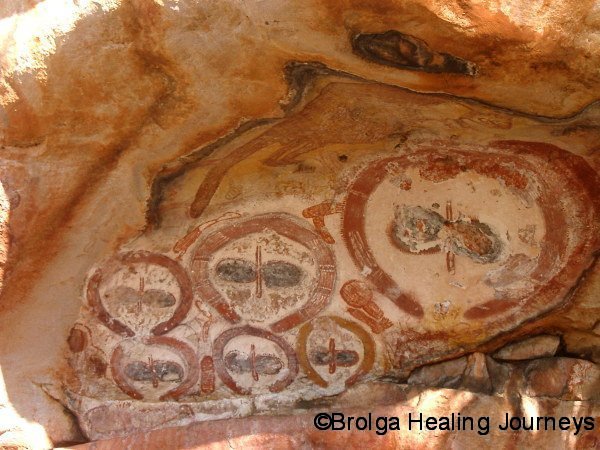
INTRODUCTION
Visiting a Wandjina site is, without doubt, the most dramatic experience in rock art. The Wandjina is an ancient, powerful, mysterious and deeply spiritual symbol.
The Wandjina represents the creator spirit for the Aboriginal people of the Kimberley region. These striking figures, some dating back thousands of years, are found throughout the Kimberley in rock art sites. The Aboriginal people treat these sites with respect and caution, indeed often approaching Wandjina sites with a wariness bordering on fear. The Aboriginals tend not to stay at the sites for long, for they believe that the Wandjina are present at the sites, and you don’t want to anger them by overstaying your welcome. Initiated elders were responsible for refreshing the Wandjina figures in their tribes’ sacred sites in traditional times, in other words, repainting the figures. This still occurs in a handful of sites but many images are now fading due to the loss of traditional ways. The Aboriginal people believed that the Wandjinas were responsible for bringing the annual rains and storms to the region, and thus the people refreshed the images annually to maintain the power of the Wandjinas and ensure the return of the rains and renewal of fertility to the area. The image of the Wandjina is reminiscent of the enormous storm-cloud formations which bring rain to the Kimberley each Wet season.
Wandjinas also gave the traditional law to the people. The Wandjina therefore forms a central part of the culture of the region. Wandjinas are usually portrayed with a halo-like ring around their head and no mouth; they are all-seeing and all-knowing and have no need for speech.
There is much about the Wandjina that I do not understand, for my experience with them is brief and I do not have the traditional knowledge of them. Nonetheless, in my experience every Wandjina art site is special; they are indeed powerful, spiritual places that inspire respect and awe. A visit to any Wandjina site is an amazing experience.
Most Wandjina sites are located under rock overhangs, which have served to protect the art from moisture and wind. The predominant rock throughout the Kimberley is the King Leopold sandstone, smooth, hard and pale, and therefore perfect for rock art.
OUR EXPERIENCE OF THE WANDJINA
Like most Australians, our first glimpse of a Wandjina came during the Opening Ceremony of the Sydney Olympics, when the enormous image of a Wandjina appeared to rise up out of the ground. This was a breathtaking moment and one of the highlights of that famous ceremony.
2002 Bush University
Two years later, Nirbeeja and I embarked on a Bush University tour of the Kimberley, organized by our friend Maggie Sands. The Bush University was the brainchild of the late Kimberley Aboriginal elder David Mowaljali, a true visionary. The aim of the Bush University was to take non-Aboriginals to the Kimberley and educate them in traditional ways, in order to deepen their understanding and appreciation of Aboriginal culture.
The tour was a great experience. Seemingly in the blink of an eye, we had left Canberra and were flying across the Kimberley in a light plane, battling into strong winds, as we headed towards some remote place know as the Mitchell Plateau. I remember looking out the window at the apparently changeless landscape below, wondering if there was ‘anything’ down there.
Indeed there was. A timeless, ancient and powerful place that remains largely untamed by the modern world. We landed on the dirt runway, thankful to be in one piece, and commenced some life-changing adventures.
Our tour began in the region of the Mitchell Falls, where we were led by Sylvester, a knowledgeable and entertaining Wunambul man. He introduced us to the ways and stories of his people, and also took us to our first Kimberley rock art sites. Powerful spirit figures, and enigmatic Gwion Gwion figures, stared down at us from the sandstone walls.
Heading down from Mitchell Falls, we came to the King Edward River and the Munurru art sites. These were powerful places, and were home to the first Wandjina images we had encountered. The Wandjina figures had a sense of presence and power and, I must say, were slightly unsettling.
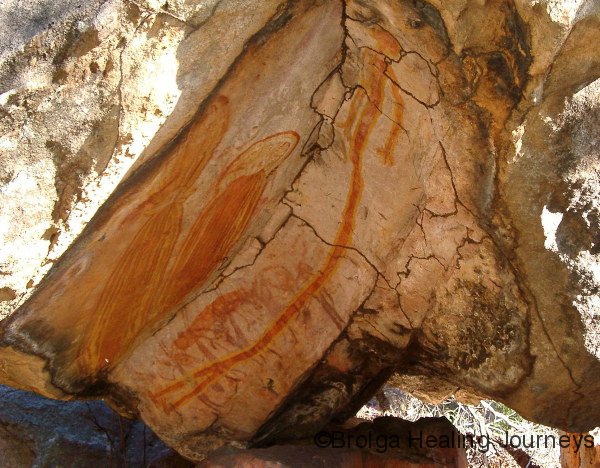

We then stayed some days at Marunbabidi, a remote camp, with some prominent Ngarinyin elders led by Paddy Neowarra and Pansy Nulgit. Our time with them served as our true introduction to the ways of traditional Kimberley peoples.
We visited two Wandjina sites with them – Eagle Rock and Donkey Creek. Paddy Neowarra, as senior Elder, led the group in to each site.
The approach to Donkey Creek is something I will never forget. From a remote, deliberately concealed car-park, we walked hundreds of metres in single file, through chest high grass in the late afternoon sun. The air was perfectly still. An expectant hush fell over our normally chatty group. As we drew nearer to the site, Paddy began to call to the resident spirits in his language. His lone voice called out again and again, seeking permission from those spirits for our party to visit the site. As we continued, we became aware of a rock outcrop to our right, and then we saw them – a line of Wandjina spirits along the base of the outcrop. This was a breathtaking, potent site.
The Donkey Creek Wandjinas are known as the Cuckoo People, representing a lineage of Wandjina spirits; they also record the history of the Ngarinyin people.
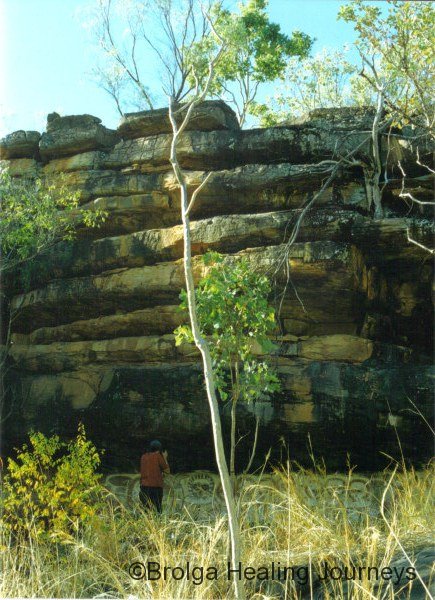
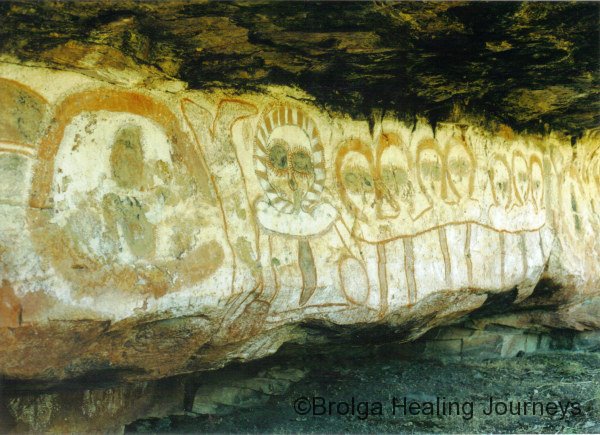
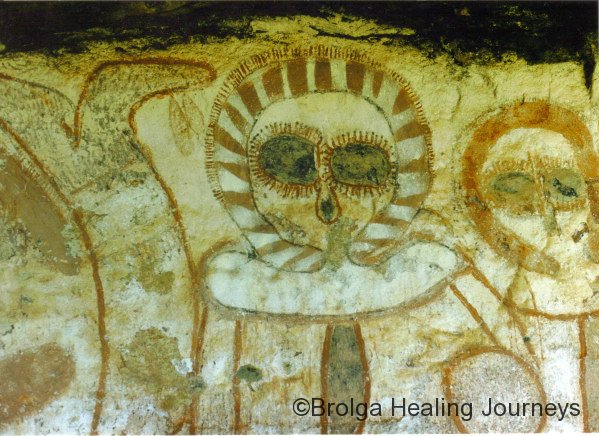
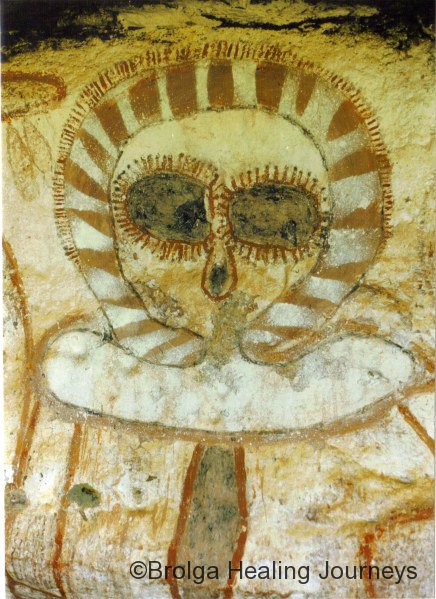
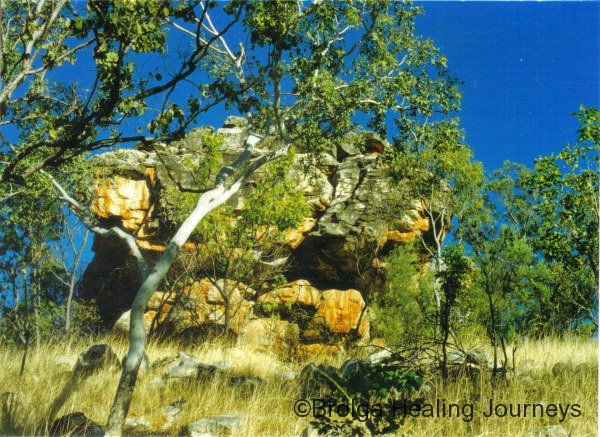
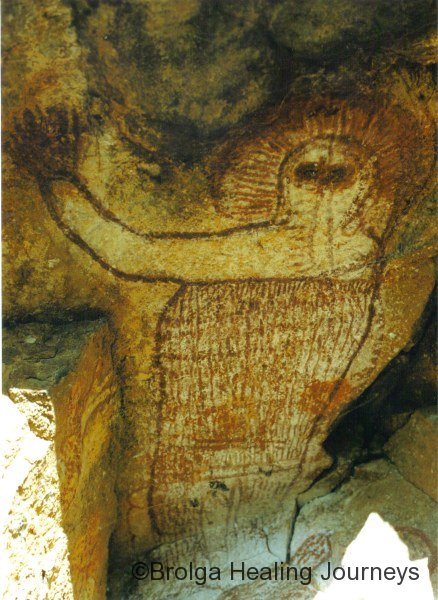
We visited a further Wandjina site on that trip, at Galvan’s Gorge, some distance down the Gibb River Road.
- Postscript to 2002 tour
We know that Maggie Sands, who organised our trip to the Kimberley in 2002, was keen for members of our group to have life-changing experiences there. All I can say on behalf of this couple, is that the Kimberley journey of 2002 had a profound effect on our lives, and it is no exaggeration to say that it was a major inspiration for the lifestyle we now lead. A photograph of the Donkey Creek Wandjinas, which served in our Canberra home to inspire us to embark on our current travels, now looks down at us from the living area of our camper trailer. Like much of the art itself, the photograph is somewhat battered looking and its colour is flaking off. But it is treasured by us.
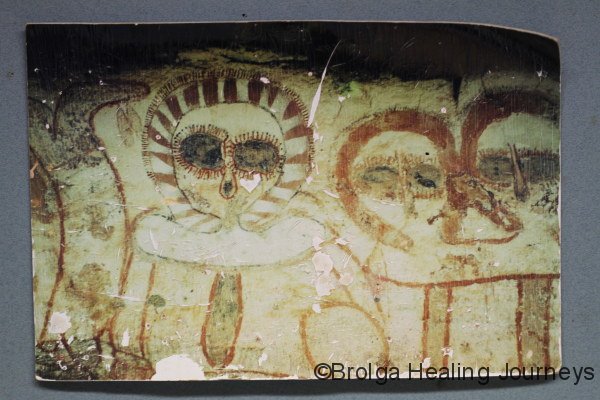
- Further postscript to the 2002 tour During our stay with the Ngarinyin elders, they had planned to take our party to another Wandjina art-site, a site now recognized under native title as belonging to them. At the time, there was a ‘joint enterprise arrangement’ in place with the nearby station, on which the art site stood, which should have entitled the Ngarinyin people access to the land. However, they were denied access to the site by the managers of the station, who represented the wishes of the station’s owner – a wealthy Melbourne QC who had purchased the property ostensibly to protect the resident rock art. Despite denying our party access to the site on the grounds that we might damage the art, even though we were with representatives of the very people who had maintained the site for centuries, this property ‘owner’ and his station managers have a reputation for taking their wealthy friends on exclusive rock art tours to those very sites. If you are interested in reading further about what I consider arrogant and racist behaviour, the following link takes you to a paper by an academic of the Australian National University. Interestingly, the paper makes direct reference to our 2002 experience.
http://epress.anu.edu.au/caepr_series/no_27/mobile_devices/ch04.html
Fast-Forward to 2009
As I mentioned above, our 2002 Kimberley experiences inspired much of what we are doing now. When we left Canberra in late July 2007, a return to the Kimberley was high on our list of priorities. Well, we did get there, even if it took us the best part of two years!
Mowanjum Art Centre
On this journey, we came to the Kimberley from the south, firstly to the Broome region, then on to Derby. The Derby region marks the south-western boundary of the rugged ranges for which the Kimberley is so well known, and which are home to the rock art sites featuring Wandjina and Gwion Gwion (or Bradshaw) figures. It was therefore fitting to find the Mowanjum Art Centre located nearby, just a few kilometres from the start of the Gibb River Road. This impressive art centre features paintings by many well-known Aboriginal artists, including Donny Woolagoodja, the elder who designed the famous Wandjina image of the Sydney Olympics. The art centre features some beautiful art works, displayed by artist family group. From the air, the art centre is designed to portray a Wandjina.
Windjana Gorge
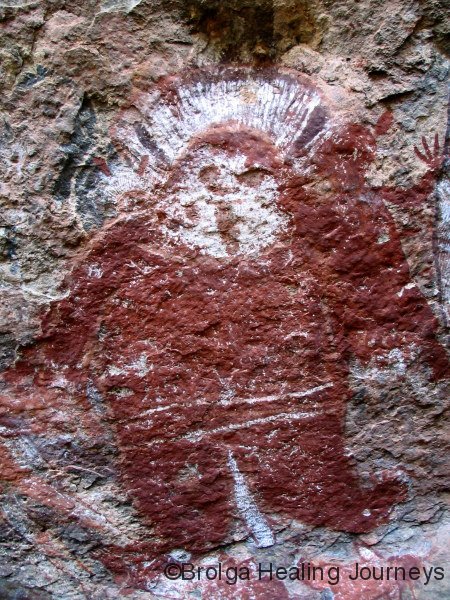
From Derby, we began our adventures up the famous Gibb River Road. First stop was Windjana Gorge, in the ancient Napier Range. The name itself probably derives from a white-man variation on the name “Wandjina’. The gorge itself cuts 3.5km right through the Napier Range – a limestone range formed at same time as Mimbi Caves and the famous Geike Gorge. On our last tour to the Kimberley 7 years ago we had walked in and straight out, getting barely a glimpse of Windjana Gorge. This time we could explore properly and enjoy the area’s riches. The gorge was full of beautiful limestone formations, sunsets glowing off the cliff-face, along the length of the gorge fresh-water crocodiles sunbaked on the sands, archer fish shot down their prey with a spit of water, and there were lots of birds. Nirbeeja even spotted the elusive Small Eared Rock Wallaby.
Part way into the gorge is a huge limestone rock, named Bandangnan, straddling the water. To the local people this was the boss-man rock – the rock in charge of Windjana Gorge. At the other end you come to an area named Djamburrwurru, that translates as ‘roaring of the waters’. When the flood waters pass down the Lennard River each wet season, they apparently cause an enormous roaring sound.
And some way around the escarpment beyond the end of the gorge I located a Wandjina art site, named Langurrngurru after the chief Wandjina portrayed at the site. This was a spectacular place, situated next to a deep cave, high up on the cliff-face with breathtaking views of the surrounding landscape, grasslands and Lennard River. A magnificent stand of boab trees are aligned like guardians along the base of the cliff. There is extensive art at the site, though much has faded through natural decay. Fortunately, this is not an easy site to find and relatively few people visit it. There was no evidence of graffiti or deliberate damage to the site.
Climbing the cliff to the site I was at first disappointed to hear other voices – but met Graham and Merrilyn, a couple from Melbourne who had been to the site 15 years ago. Graham said that revisiting this special place was on his “hundred things to do before he died”. We shared a sense of awe at the site and found we had many attitudes in common. We were all glad that it was relatively inaccessible, because this meant there would most likely be less damage to the site.
Before going to the site I had first checked with the Aboriginal ranger at the campsite that it was okay. I had also asked if there were other sites in the area I could visit. He said that there were other sites near Windjana Gorge, but non-aboriginals couldn’t visit. I respected that restriction and in fact I am glad that some sites are off-limits. I think when he realized that I had no problems with being told ‘no”, he proceeded to give me details of sites near Tunnel Creek that I could visit. I knew about one of them but not the other. I regard the Ranger’s advice as a real bonus.
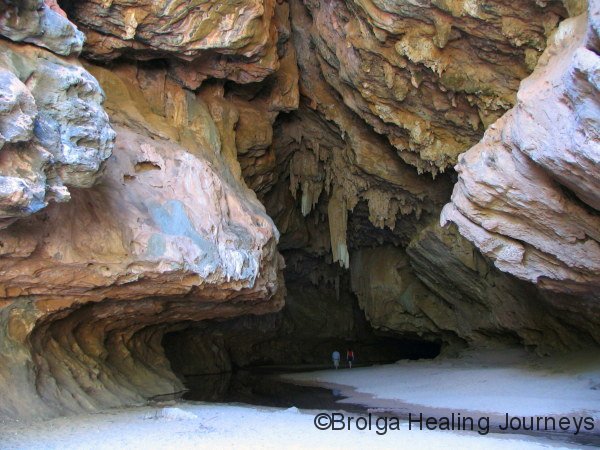
Galvan’s Gorge
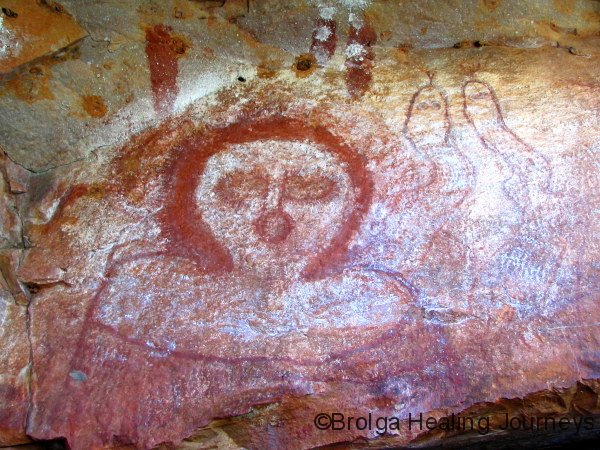
Our next Wandjina art-site was at Galvan’s Gorge, a considerable distance north along the Gibb River Road. Galvan’s Gorge is a beautiful, relatively small, horse-shoe shaped gorge with Wandjina rock art. We had visited this gorge on our previous Kimberley trip, but if anything it seemed prettier this time. For a short while we had the gorge all to ourselves, I had a swim while Nirbeeja did some bird-watching. We were pleased to see that the gorge remains home to a large colony of Merten’s Water Monitors.
Wunnumurru Gorge
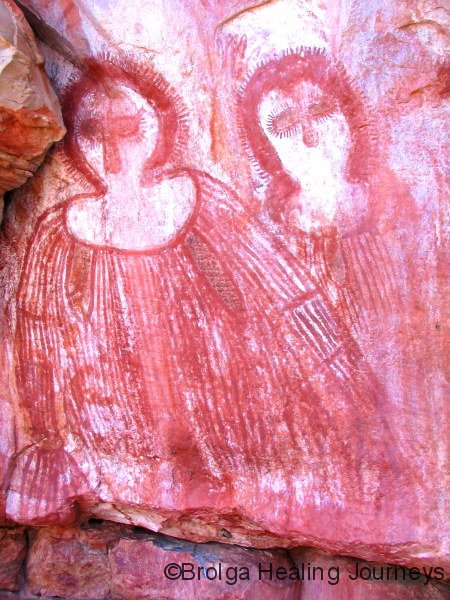
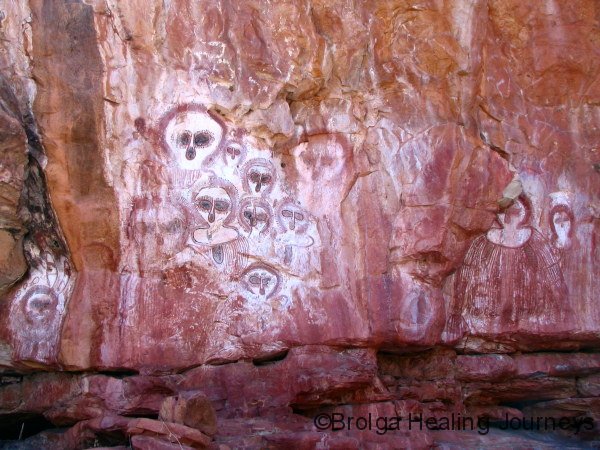
We continued our journey to Mt Elizabeth Station, a family owned cattle station in the heart of the Kimberley, with a rich history. The 30km road linking the Gibb River Road to the station varied from good to atrocious, but the campsite was an oasis, as was the homestead. Squawking Rainbow Lorikeets (the Red-Collared race seen in the Kimberley region) entertained us here, as did the Station’s peacocks, which are beautiful creatures but not so endearing when they constantly jump onto your car’s bonnet to admire their reflection in the windscreen.
We travelled from the homestead out a 10km track to the Wunnumurru Gorge, the Aboriginal name for a stretch of the Barnett River Gorge that passes through the station. This was definitely a 4WD-only track, the most challenging we had passed along on the whole trip. Lots of low-range rock hopping, ‘walking’ the car across boulders and sharp rocks. I’m happy to report that car and its occupants survived the experience. At the far end (10km can seem a long way after such a drive!) we reached another gorge that would vie for the title of most beautiful we have seen. A waterfall drops into a clear, deep pool which is reached across a gradually sloping sandy base from a shaded beach. Figs trees and ferns surround the pool. 500 metres downstream we visited a magnificent art-site; a special place with Wandjina upon Wandjina. A place to stand in awe and immerse yourself in the ancient spirit of the land.
After a swim we ventured across the face of the waterfall to explore the far cliff-face and were rewarded to find more rock art, less obvious than the Wandjina site but still inspiring. Prominent was an ancient, faded drawing, several metres long, of a snake. We were admiring this painting when I looked into a couple of cracks in the rock face immediately above and below the painting, and was shocked to realize that live snakes resided there. They were quite dramatic – striped orange-brown and white. We have since learned that these were the Northern Brown Tree Snake, regarded as venomous but not dangerous. I guess their bite would make you sick but probably not kill you. We admired them from a respectful distance, wondering if the snake painting was put there to warn people, who knows how long ago, that “snakes are here”, or whether the snakes somehow attracted by the site. Food for thought.
Wandjina sites on El Questro Station
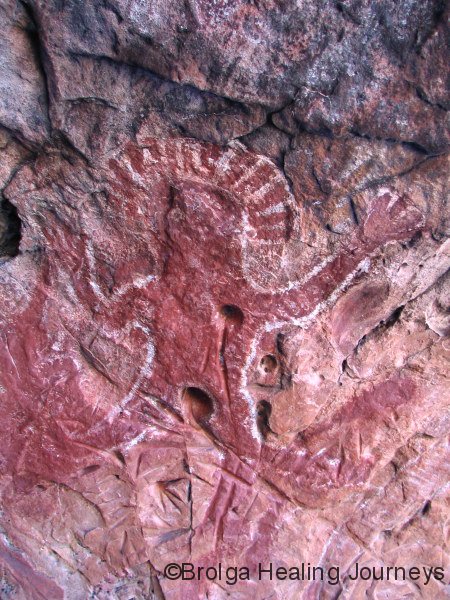
Much further along the Gibb River Road, and some distance from Emma Gorge, on El Questro Station, sits Gninglig, a large rocky outcrop, which once provided shelter and food for the local tribes. The rock features several interesting art sites. We were lost in a reverie, dreaming of times past, when the Aboriginal peoples of the area lived here, hunting and simply being, without a thought to the changes that would later come to their land. This area was once included in El Questro tours but has now been excised from them due to native title claims. We consider ourselves privileged to have been allowed to visit this site.
A little further along the Gibb River Road was a loop road to Matteo Rock, another interesting Wandjina art site.
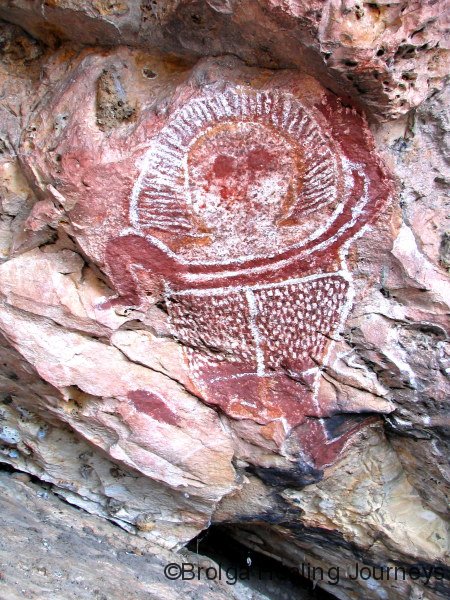
Wyndham region
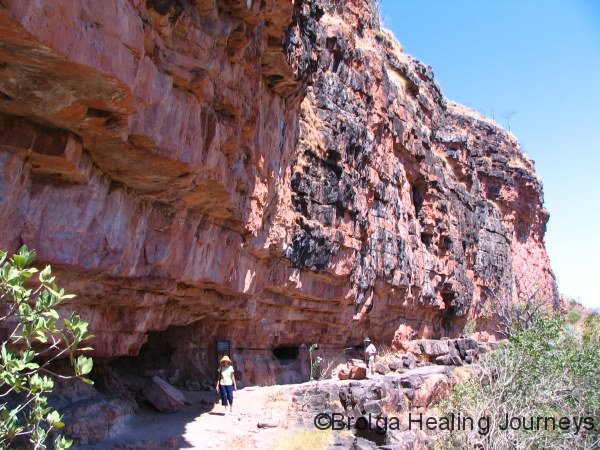
South of the small town of Wyndham, in the north eastern Kimberley, is a magnificent rock face and overhang containing some old and faded rock art. This site is not far from a place know as Digger’s Rest .
Keep River National Park
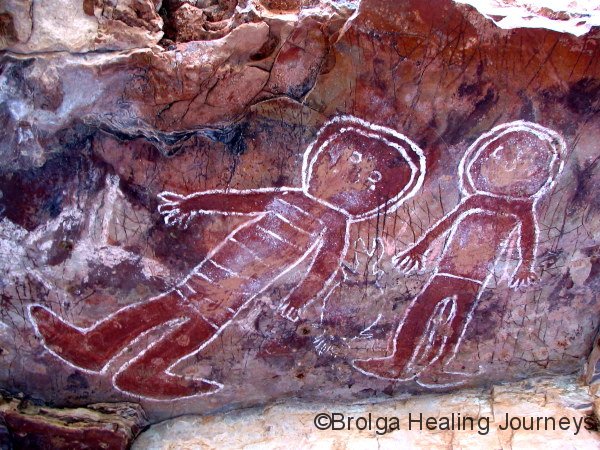
We left Western Australia, crossing into the Northern Territory east of Kununurra. Our first stop was the Keep River National Park. Whilst our artifical, modern borders locate the national park within the NT, its culture, geology, flora and fauna all betray strong links with the Kimberley.
The weather conditions during our stay were oppressive; 39 to 40 degrees in the shade during the day, mid 30s overnight, and high humidity throughout. Nevertheless, we completed all the walks offered in the national park and enjoyed them all. The park features some spectacular sandstone formations – similar to those in Mirima National Park near Kununurra, and the Bungle Bungles further south – as well as the scenic Keep River gorge and some very interesting Aboriginal occupation and art sites. Unfortunately, one site normally open to the public was closed during our visit because of a suspected arson case. We did however encounter some magnificent rock art, including some Rainbow Serpent paintings many metres in length in a hidden art-site that Nirbeeja chanced to see while we were on a walk, and some interesting Wandjina figures that would have had Erik von Daniken salivating, which we also located in an art site off the usual track.
We hope you have enjoyed this post. We would strongly encourage anyone with an interest in Aboriginal culture to travel to the Kimberley and experience the Land of the Wandjina for themselves. We hope, ourselves, to return there soon.

















































































I still have a postcard of the Wandjina from when Maggie Sands came to the Hierophant all those years ago. I had it on my wall for years. I felt it helping my journey in some way. I didn’t get to the Bush Unitversity but I did end up in the Northen Flinders rangers (SA) at a place called Iga Warta. An experience I shall always remember. Thank you for your log of the Wandjina.
Thanks Christiana Rose. Yes – the sites and the Wandjinas are special and powerful. I’ll make sure we get to Iga Warta one day!
Lovely to see thanks for sharing.
Dear peter Rawlings. I am planning to go to kimberley. If you have any more detalied info where to see those rock arts like The Donkey Creek Wandjinas and also the aboriginal people like Sylvester, Ngarinyin elders led by Paddy Neowarra and Pansy Nulgit. And if you know some who planning to go to that area, let me know
Those are beautiful rock art. It shows that people during the ancient times have a profound sense of art. I am planning a kimberley trip and I hope to see these amazing artworks in Wandjina.